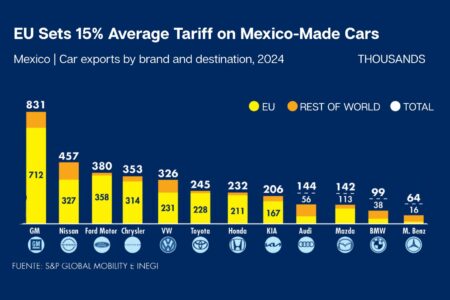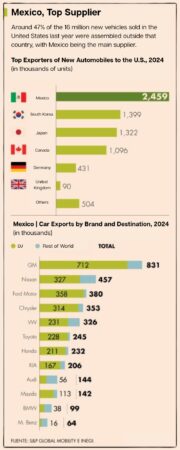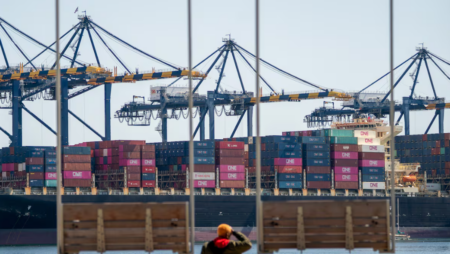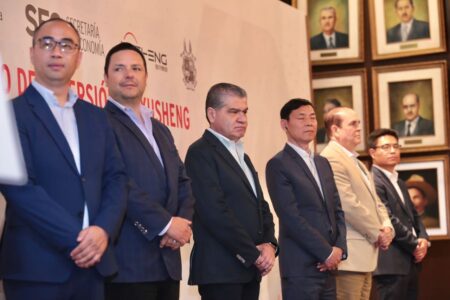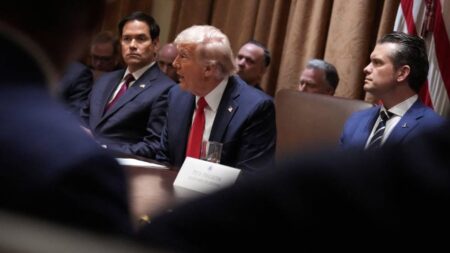El martes entraron en vigor los aranceles generales del 25% que impuso el presidente Donald Trump a México y Canadá, una medida extraordinaria que tiene como objetivo poner en su lugar a los principales socios comerciales de Estados Unidos, pero que amenaza con debilitar la economía norteamericana, incluida la de Estados Unidos, en un momento de gran estrés para los consumidores, cansados de la inflación.
Trump también duplicó los aranceles sobre todas las importaciones chinas del 10% al 20%. Esos aranceles se suman a los aranceles existentes sobre cientos de miles de millones de dólares en productos chinos. China y Canadá respondieron de inmediato con aranceles sobre productos estadounidenses, amenazando con encender una dañina guerra comercial. México dijo que anunciaría medidas de represalia el domingo.
La administración Trump dijo que los aranceles eran necesarios para detener el flujo de fentanilo a Estados Unidos.
“Si bien el presidente Trump dio a Canadá y México amplias oportunidades para frenar la peligrosa actividad de los cárteles y el flujo de drogas letales hacia nuestro país, no han logrado abordar adecuadamente la situación”, según un comunicado publicado por la Casa Blanca poco antes de que los aranceles entraran en vigor.
Pero los aranceles llegan en un momento en que la inflación sigue siendo obstinadamente alta. Los estadounidenses, y la economía estadounidense en su conjunto, están en una situación más inestable , como lo demuestran los datos recientes.
Los aranceles de Trump amenazan con aumentar los precios que pagan los estadounidenses por una amplia gama de bienes importados de los tres países, que en conjunto enviaron a Estados Unidos bienes por un valor de 1,4 billones de dólares el año pasado, según datos del Departamento de Comercio. Eso representa más del 40% del valor de todos los bienes que Estados Unidos importó el año pasado.
Los únicos productos que no estarán sujetos a un arancel del 25% desde Canadá son los relacionados con la energía, como el petróleo crudo, uno de los principales productos que Estados Unidos importa desde ese país. En cambio, estarán sujetos a un impuesto del 10%.
Los productos frescos, los automóviles y sus componentes , y los productos electrónicos, incluidos teléfonos y computadoras, se encuentran entre los principales bienes que Estados Unidos importa de México, Canadá y China y que ahora enfrentarán aranceles de entre el 20% y el 25%.
Las acciones de los fabricantes de automóviles globales que tienen plantas en México cayeron drásticamente el martes por la mañana. La alemana Volkswagen cayó casi un 4% a las 5.46 am ET, mientras que Stellantis ( STLA ) -el fabricante de Chrysler y Jeep- cayó casi un 7%.
China y Canadá contraatacan. México es el siguiente
Pekín respondió el martes con el anuncio de aranceles del 15% a las importaciones de pollo, trigo, maíz y algodón de Estados Unidos, según un comunicado de la Comisión Arancelaria del Consejo de Estado. Además, también se impuso un arancel del 10% al “sorgo, la soja, la carne de cerdo, la carne de vacuno, los productos acuáticos, las frutas, las verduras y los productos lácteos”, añadió.
Por otra parte, el Ministerio de Comercio de China dijo que agregó 15 empresas estadounidenses, incluido el fabricante de drones Skydio, a su lista de control de exportaciones, lo que prohibiría a las empresas chinas exportarles equipos de doble uso.
Los aranceles de represalia de China siguieron un “enfoque moderado y específico destinado a causar daño a las industrias que más importan a los partidarios de la administración Trump”, dijo Alfredo Montufar-Helu, director del Centro de China para el Conference Board. Señaló que los aranceles de China le dan margen para negociaciones para evitar potencialmente aranceles aún más perjudiciales en el futuro.
En una conferencia de prensa habitual el martes, Lin Jian, portavoz del Ministerio de Asuntos Exteriores de China, dijo: “China luchará hasta el final” si Estados Unidos “insiste en librar una guerra arancelaria, una guerra comercial o cualquier otro tipo de guerra”.
“Quiero reiterar que el pueblo chino nunca ha temido al mal ni a los fantasmas, ni nos hemos doblegado jamás ante la hegemonía o la intimidación. La presión, la coerción y las amenazas no son las formas adecuadas de relacionarse con China. Tratar de ejercer la máxima presión sobre China es un error de cálculo y un error”, añadió.
China anunció el martes más medidas contra Estados Unidos, entre ellas la suspensión de las importaciones de madera de Estados Unidos, la suspensión de los permisos de tres empresas estadounidenses para exportar soja al país y una investigación antidumping sobre algunas importaciones de productos de fibra óptica estadounidenses.
Parte de la motivación declarada de Trump para imponer aranceles a China, Canadá y México es presionar a esos países para que ejerzan controles más estrictos sobre el flujo de fentanilo hacia Estados Unidos.
Las fuerzas de seguridad de Estados Unidos creen que varias entidades con sede en China suministran productos químicos precursores que pueden usarse para fabricar fentanilo terminado en laboratorios operados por cárteles de la droga en Estados Unidos y México.
El martes, la Oficina de Información del Consejo de Estado de China publicó un documento que describe las medidas que el gobierno ha adoptado en los últimos años para controlar la producción y distribución de sustancias relacionadas con el fentanilo, según la agencia de noticias estatal china Xinhua. En referencia al enfoque de China para el control internacional de drogas, Xinhua citó el documento diciendo que el país “aboga por la asistencia mutua… y se opone a señalar con el dedo y a pasarse la pelota”.
El primer ministro canadiense, Justin Trudeau, advirtió el martes en una conferencia de prensa que Canadá “no se rendirá en la lucha”. Dijo que implementaría un arancel del 25% sobre 30.000 millones de dólares canadienses (20.700 millones de dólares) de productos estadounidenses de inmediato, seguido de otros 125.000 millones de dólares canadienses (86.200 millones de dólares) en un plazo de 21 días.
“Es una tontería”, dijo, en comentarios que dijo que estaban dirigidos a Trump. “Que dos amigos nos peleemos es exactamente lo que nuestros oponentes en todo el mundo quieren ver”.
Los productos lácteos, las carnes, los cereales, el vino, la cerveza, las prendas de vestir, el calzado, las motocicletas, los cosméticos y ciertos productos de pulpa y papel son solo algunos de los productos estadounidenses que estarán sujetos a aranceles inmediatos, según el Departamento de Finanzas de Canadá.
“We will also be challenging these illegal actions by filing dispute resolution claims at the World Trade Organization and through the USMCA,” Trudeau noted. “In the meantime, our tariffs will remain in place until the US tariffs are withdrawn and not a moment sooner.”
If tariffs don’t cease, Trudeau said his government is in active conversations with provinces and territories to pursue several non-tariff measures “measures that will demonstrate that there are no winners in a trade war.”
The premier of Ontario, Canada’s largest province, has also repeated his earlier threat to cut off energy supply to the US in response to Trump’s tariffs.
“If they want to try to annihilate Ontario, I will do everything, including cut off their energy, with a smile on my face. And I’m encouraging every other province to do the same,” Doug Ford told reporters on Monday, adding that eastern US relies on “our energy — they need to fell the pain.”
Despite Trump’s prior claims that exporters pay for tariffs, it’s actually the parties receiving goods from abroad that pay the tariff upfront. Those parties, often businesses, typically then pass on the additional tariff costs to consumers by raising prices. But in some cases, they may opt to, or be forced to, absorb the higher costs.
Mexico’s President Claudia Sheinbaum said on Tuesday morning that she would announce retaliatory tariffs on American imports into Mexico, as well as non-tariff measures, on Sunday. She said she will probably have a call with Trump on Thursday.
“The unilateral decision made by the United States affects national and foreign companies operating in our country, as well as our people,” she said at a press conference in Mexico City. “No one benefits from this decision.”
Although America’s economy remains resilient, tariffs come during a time of increasing cracks in the foundation. A Bureau of Economic Analysis report Friday showed consumer spending unexpectedly fell in January, and a recent inflation report showed consumer prices rebounded in January and inflation continues to grow at a stubbornly high pace.
Meanwhile, consumer confidence fell the most to start a year since 2009, and a separate consumer sentiment report last month registered the biggest decline since records began in 1978. That’s a problem because consumer spending makes up more than two-thirds of America’s economic activity.
Friday’s jobs report is expected to show growth continues to stagnate. First-time applications for jobless benefits ticked up more than expected last week, and the Trump administration is laying off thousands of federal workers, potentially disrupting local economies. Federal spending has also been curtailed, turning off access to some people’s livelihoods and services.
Trump’s immigration crackdown also threatens homebuilding, agriculture and other key industries.
“Imponer aranceles a Canadá y México amenaza con enfriar un esfuerzo de colaboración para fortalecer nuestra frontera compartida y corre el riesgo de iniciar una guerra comercial con los socios comerciales más cercanos de Estados Unidos”, dijo la vicepresidenta de política comercial global del Consejo Nacional de Comercio Exterior (NFTC), Tiffany Smith, en un comunicado el lunes.
Smith dijo que la NFTC, una organización comercial, apoya el objetivo de la administración Trump de “abordar la actividad ilícita en nuestras fronteras”. Sin embargo, están “profundamente preocupados” por los nuevos aranceles, que según afirman “aumentarán los costos para las empresas y los consumidores estadounidenses y socavarán el crecimiento económico de Estados Unidos”.
Trump y su administración han sugerido que la última ronda de aranceles, aunque significativa, es solo el comienzo.
Trump respondió el martes a Trudeau amenazando con aumentar “inmediatamente” los aranceles recíprocos al país vecino.
“Por favor, explíquele al gobernador Trudeau, de Canadá, que cuando él impone un arancel de represalia a los EE. UU., nuestro arancel recíproco aumentará inmediatamente en una cantidad similar”, escribió Trump en una publicación de Truth Social .
Los aranceles recíprocos de Estados Unidos, que podrían igualar dólar por dólar a los de otros países, entrarán en vigor el 2 de abril.
Los aranceles al acero y al aluminio entrarán en vigor el 12 de marzo.
Mientras tanto, Trump sigue insinuando que se impondrán más aranceles. La semana pasada, Trump firmó una orden ejecutiva para investigar los aranceles a la madera. Aunque lleva mucho tiempo sugiriendo que Estados Unidos no necesita la madera canadiense, el arancel amenaza con aumentar los precios de las viviendas nuevas, un factor clave de la inflación para las familias estadounidenses.
Trump también insinuó el lunes que impondría aranceles a las importaciones agrícolas, en un intento por impulsar las ventas internas.
